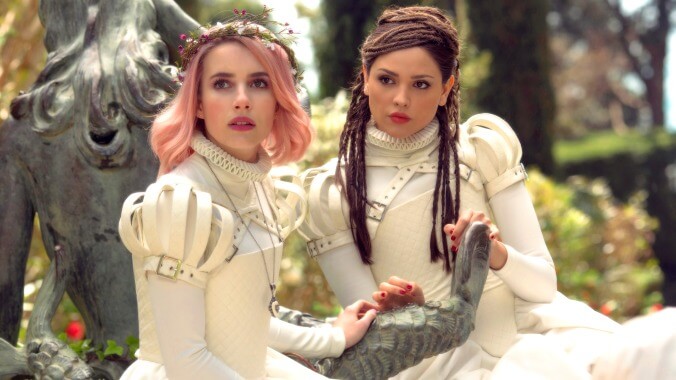Emma Roberts leads the rich-girl resistance in the exquisite, flimsy YA fantasy Paradise Hills


The thing that really stands out about Paradise Hills is the flowers. The hairstyles are also gorgeous, as are the dresses and the decor. But it’s the flowers exploding over nearly every outdoor surface that really make Spanish director Alice Waddington’s debut feature feel decadent. Waddington’s background is in fashion photography and advertising, and the film does have the meticulously executed, distinctly editorial point of view one would expect from someone in that aesthetics-first field. But while Paradise Hills has a more conventional, YA-style plot than most recent films by fashion creatives—think Woodshock, from Rodarte founders Kate and Laura Mulleavy, or even Tom Ford’s Nocturnal Animals—this accessibility actually hurts the film, exposing the flimsy balsa-wood architecture under all those frills.
Emma Roberts stars as Uma, a poor little rich girl whose background—her father was a brilliant inventor whose genius allowed him upward mobility in a highly stratified society—gives her that special “not like other girls” quality of a YA heroine. Her problems are strictly fairytale princess stuff—namely, her impending marriage to a sinister CEO who Uma describes as a “sociopath.” She resists the marriage literally kicking and screaming, prompting her family to send this “nasty little thorn in Mother’s side” off to the film’s eponymous school for rebellious daughters of the upper classes. It’s a lavish wedding cake of a compound, where students/patients/prisoners get makeovers, do yoga, and perform brainwashing “therapy” under the eye of headmistress The Duchess (Milla Jovovich).
Once she arrives, Uma falls in with a clique of girls, each of whom has committed her own individualistic sin: Yu (Awkwafina) is a metalhead prone to panic attacks, while Chloe (Dumplin’s Danielle Macdonald) has a body that doesn’t conform to her mother’s stick-thin ideal. Rumor has it that pop star Amarna (Eiza González) was sent to Paradise Hills because of her alcoholism, but really she fell in love with another woman, a serious transgression in this strictly patriarchal world. The relationship between Amarna and Uma initially seems to suggest shades of But I’m A Cheerleader, but ultimately the film’s flirtation with queer romance remains exactly that: a flirtation. It is refreshing to see genuinely supportive sisterhood among the core ensemble, though, along with the film’s expansive view of gender roles and femininity.
Paradise Hills does serve as an exquisite calling card for production designer Laia Colet, who also worked on Lucile Hadzihalilovic’s Evolution. What Colet and her crew were able to accomplish here is extraordinary, a spun-sugar fantasy of a movie that looks like it cost at least five times its actual budget. (Reports out of Sundance placed the film’s cost at about $10 million.) The sets of Paradise Hills are a child’s dream bedroom on steroids, draped in luxurious fabrics and adorned with delicate details over dramatic Spanish architecture amid gently swaying cherry blossom trees. It looks like a place where a unicorn might hang out—and there almost is one, in the form of a Ludovico machine modeled after a carousel horse.
The costumes are similarly elaborate, with an emphasis on flouncy dresses and exaggerated silhouettes in soft, feminine shades. 3D printed accessories like the face cage that Roberts wears in the film’s opening scene add just a slight sci-fi edge, as does a brief shot of a flying car pulling away from a stately mansion. (It’s not clear whether the film is set in the future or another reality entirely, however.) Waddington further enhances this slightly skewed, hyper-feminine aesthetic with a softer take on the famous colored lighting in Dario Argento’s Suspiria, utilizing shades that range from from mint green shadows to neon pink flames. But the film isn’t just as opulent as a Fabergé egg. It’s as flimsy as one, too.
The world building is the first to show cracks: This is obviously some sort of dystopian fantasy realm, but beyond that the details are sketchily drawn and inconsistent. The emotional beats aren’t so concrete either, thanks to the unclear backgrounds of the core cast of characters and the tenuous relationships between them. And as the film progresses, González, Macdonald, and Awkwafina all fade into the background, while Jovovich ups the camp villainess factor; in fact, there’s not much difference in her approach to the climax of this film than the one she took with this year’s Hellboy.
But Paradise Hills really stumbles when it dives into class politics, delivering extremely mixed messaging that simultaneously pities and vilifies the “lowers” who work at this pastel prison for wayward rich girls. There doesn’t seem to be any malice behind this characterization, however, merely obliviousness. For teenagers—or adults who prefer teenager-centric entertainment—the generic fairy-tale setup and shallow plot aren’t especially unusual, and may not be much of a barrier. But if you don’t especially miss The Hunger Games and its similarly lavish Capitol, you won’t be missing much here, either.